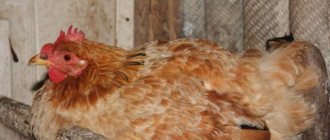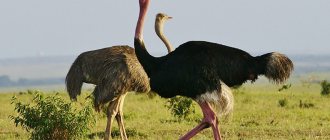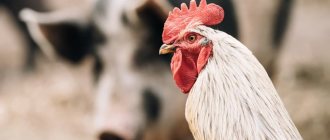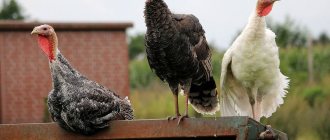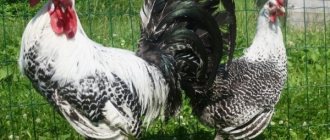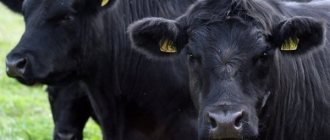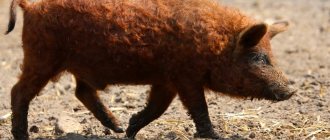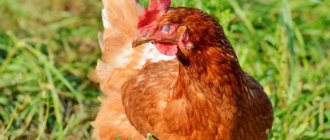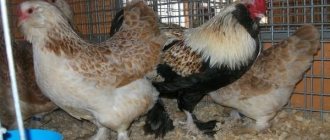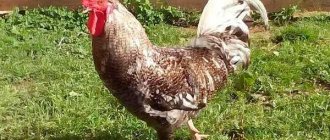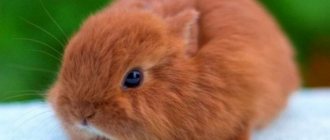1 956
no comments yet
0
Author:
Rasskazov Pavel.
Reading time: 2 minutes
Young poultry obtained from crossing meat-combined lines for growing for meat and characterized by rapid weight gain are called broilers.
Typically, such crosses are 20-30% larger than purebred birds. At the age of 60 days, young broilers can be sent to slaughter: their weight during this period reaches 1.5-2 kg.
Broiler meat is considered a dietary product. It is non-greasy, soft, tender. Can be used to feed children, the elderly, during illness and recovery periods.
What are the advantages and features of colored broilers
Unlike other crosses, colored broilers are characterized not only by high meat productivity, but also by good egg production. You can get from 180 to 300 eggs per year from one hen. The meat productivity of such crosses is 4-6 kg.
Colored broilers are characterized by the following external characteristics:
- wide powerful back;
- elongated muscular torso;
- large chest;
- thickened strong paws;
- colorful plumage.
Colored broiler chickens are characterized by rapid growth. The average daily weight gain of young animals is 60 grams.
Problems during selection, disadvantages of individuals
Broilers cannot be too small; already 1 month after hatching, the chickens look like 2-3 month old chickens. If this is not the case, then an unscrupulous seller has been caught who passed off a bird of a different breed as a colored broiler.
Sometimes birds begin to limp or stop growing. In this case, the breeders are not to blame. Attention should be paid to the nutrition and maintenance of individuals.
Low quality feed, spoiled or not containing the required amount of vitamins, provokes lameness. Lack of light and crowding lead to stunted growth.
Incubation
To obtain young colored crosses of appropriate productivity, hatching eggs are purchased from breeding farms. The peculiarity of the incubation of such eggs is the duration of ventilation . They need to be cooled for 30 minutes 2 times a day, unlike the eggs of other laying hens, which require two 10-minute airings.
Chick development by day. Signs of correct and incorrect development of the embryo
Read
How to choose the right eggs to put in the incubator?
Answer
Brooders for chickens in different price segments. For hobbyists, farmers and industry
Top – 9
Review of industrial and amateur incubators for breeding chickens
Top – 15
Keeping meat chickens
Photo of broiler chickens
You cannot hope for high productivity of broilers if nothing is done for the welfare of the birds. Even the best cross will not give the desired results and will often get sick if it lives in poor conditions. So, how are broiler chickens kept?
- There must be a holding room, even if the bird is kept in an aviary. Cold days happen in all regions. Hurricanes, slush, strong winds and other disasters can be dangerous for birds. It is for such purposes that they need shelter. Let it be a small room, but comfortable, so that the chickens have enough space there - cozy, warm and calm.
Important! A large chicken coop is really expensive to build, but if the flock is small, a small chicken coop with several tiers will be enough!
- The floor in the chicken coop should be warm. For this purpose, bio-litter or a thick layer of simple litter is used. If winters are very cold, you can also raise the floor by 20-25 cm and then lay the bedding. The air cushion will allow you to retain heat inside longer.
- Inside the chicken coop, the temperature that is normal for the birds must be maintained (+20...+28 degrees in summer and from +15 degrees in winter), natural and artificial ventilation must be provided, and humidity is maintained at a normal level.
Important! The chicken coop must have artificial light. This is necessary to make it convenient to enter the chicken coop in the evening to collect eggs and to artificially extend daylight hours in winter.
- Once every six months or year it is necessary to disinfect the chicken coop and enclosure. This is done to prevent various diseases and pests that easily settle in such premises. The chickens are temporarily moved to another place, and their home is completely cleaned with special means.
- You need to clean not only the birds’ home, but also what they use regularly: water bowls, feeders, baths with sand and shells, perches, nests. After all, as the birds live, they become polluted.
Chickens
Young chickens are usually kept in brooders until they grow up and only then are they gradually introduced to the rest of the chickens or kept in a separate pen. The diet consists of wet and dry food, which contains plenty of fats, carbohydrates and proteins
It is also very important to add vitamins and minerals. Crushed shell and gravel should always be kept in a separate basin. Fresh water must always be in the chicken coop!
Broilers are very profitable to keep. They get from them not only meat, but also eggs, although not in large quantities. The bird is distinguished by good immunity and survival; all that is required of the breeder is to choose the right cross or breed and take care of his birds.
We recommend reading our other articles
- Wintering of bees
- The best wine grape varieties
- Carrot variety Caramel
- When to plant pepper seedlings in 2022
Nutrition
The diet of colored crosses should be balanced, enriched with minerals and vitamins. The menu required for broilers includes grains, vegetables, fruits, herbs, and animal proteins. Chickens are fed 4-5 times a day with wet mash.
- Stern
- Recipes
- Supplements
Compound feed pk-1
Description of food for egg breeds. Instructions for feeding laying hens
Read
Compound feed pk-2 and pk-3
Mineral and vitamin compositions, feeding standards
Read
Compound feed pk-4
Used to feed laying hens aged 15-17 weeks
Read
Compound feed pk-5
Composition and instructions for feeding broiler chickens
Read
Purina® Pro
Important differences from the previous line, application patterns Start, Growth, Finish
Read
Barley and wheat for laying hens
Germination and steaming of barley and wheat for chickens: how to do it correctly and how to give it to laying hens
Read
Wheat for broilers
Rules for feeding broiler chickens with wheat. Dosage for chickens from the second day of life and adult birds
Read
Mash
Making mash for broilers at home
Read
Rice and buckwheat
How and in what form you can use rice and buckwheat to feed chickens. Standards for adult birds and chickens
Read
Bread
What kind of bread can you feed chickens and how to do it correctly
Read
Fish
The product is given in limited quantities: overfeeding can cause serious harm to the bird
Read
Chalk
Chalk as a food additive for chicken feed. Feeding standards for chickens, young animals and laying hens
Read
Meat and bone meal
Meat and bone meal is a mandatory additive for feeding chickens, containing protein and fats of animal origin.
Read
Fish fat
How to give fish oil to chickens, layers and broilers. What are the benefits of the drug and are there any contraindications?
Read
Limestone
Limestone (dolomite) flour in the diet of chickens. Advantage over chalk and feed shell
Read
Salt
Daily dosage of salt for adult birds and young animals and cases of unwanted use
Read
Conditions for successfully raising broilers at home
In order to preserve the chicks and raise them into healthy and strong broilers, the young animals need to be properly cared for and fed rationally.
Broiler care
- To keep chickens, a warm, dry and bright poultry house is required. The temperature in it should not fall below +2C and rise above +27C. In the first days, chickens need a temperature of at least +25C, then it can be gradually reduced.
- Birds are raised both in cages and on the floor. In the second case, no more than ten chickens can be placed on one square meter of floor.
- You should use hay or sawdust as bedding. Change the litter frequently to keep it dry. If the poultry house is clean and dry, then the possibility of infections will be minimal.
- Poultry house illumination is required to be average. Only the feeders should remain brightly lit.
If illnesses cannot be avoided, try to find out the cause of the illnesses and eliminate it. Coughing can occur if the temperature in the coop is too low and the humidity is too high. It is necessary to insulate the room, make ventilation, eliminate drafts and install a heater.
Often the cause of the disease is poor nutrition: poor food, deficiency of protein, vitamins or microelements. The diet of birds must be balanced, complete and appropriate to the age of the chickens.
Insects that parasitize birds are the main spreaders of infections. It is necessary to regularly carry out insecticidal treatment of the poultry house.
Chickens need a first aid kit with the necessary medications: antibiotics, first aid, vitamin preparations. It is important to use them correctly to prevent epidemics and death of birds.
What to feed chickens
Ready-made feed mixtures are used to feed broilers. They have a balanced composition, containing the necessary microelements and vitamins. If ready-made food is not available, you can make the mixture yourself. It includes:
- shit from corn, oats, wheat, barley;
- sunflower cake;
- yeast;
- meat and bone meal;
- low-fat cottage cheese.
The ingredients are diluted with curdled milk.
The birds are fed with wet mash of grated carrots, cabbage and other vegetables, dandelion leaves, nettles, and green onions.
Limestone, crushed shells, egg shells and chalk are added to the food. They contain calcium necessary for growth. Birds constantly need clean water.
Diseases
Colored broilers have strong immunity. The main health problems encountered in these birds are lameness and slow growth.
- Parasites
- Infectious
- Other
Chicken mite
How to treat a chicken coop and how to treat a bird. Description of drugs and methods of control
Read
Coccidiosis
Thirst, loss of appetite, swelling, bloody droppings, anemia, weakness, poor coordination
Read
Ascariasis
Loss of appetite, liquid droppings, pale mucous membranes of the comb, limbs, ruffled plumage, lethargy, vomiting
Read
Amidostomiasis
Symptoms of the acute form: apathy, general weakness, decreased or lack of appetite, breathing problems, unsteady gait, retarded growth and development
Read
Prostagonymosis
Decreased mobility, loss of appetite, unsteady gait, bloating, fever, impaired egg laying, exhaustion
Read
Knemidocoptic mange (“lime foot”)
Acute symptoms: light gray bumps appear on the legs, the bird limps and stands on one leg, the cloaca and joints become inflamed, the beak is deformed
Read
Heteracidosis
Symptoms: indigestion, diarrhea, loss of appetite, lethargy, decreased egg production, retarded growth and development
Read
Trichomoniasis
Symptoms of the acute form: fever, depression and loss of appetite, diarrhea with gas bubbles and a putrid odor, enlarged goiter, difficulty breathing and swallowing
Read
Pullorosis (typhoid fever, salmonellosis)
Weakness, lack of coordination, drooping eyelids, difficulty breathing, lack of appetite, indigestion
Read
Colibacillosis
Lack of appetite, thirst, sudden increase in temperature, pale scallops, diarrhea
Read
Pasteurellosis
Fever, foamy mucus, change in stool color, refusal to feed, thirst, lethargy, wheezing, heavy breathing
Read
Marek's disease
Paralysis of the limbs, difficulty breathing, severe exhaustion and loss of strength, refusal of food and water, pallor of the scallop
Read
Gumboro disease
Diarrhea, loss of appetite, trembling legs and head, sudden death
Read
Laryngotracheitis
Weakness, swelling of the neck, difficulty breathing, cough, wheezing, blood clots in the mucus released when coughing, lack of appetite, indigestion
Read
Bird flu
Refusal to eat, anorexia, diarrhea, purulent discharge, hoarse breathing, greenish-brown droppings, seizures, darkening of the ridge
Read
Newcastle disease
Decreased appetite, fever, respiratory distress, immobility, conjunctivitis, bloody diarrhea
Read
Apteriosis
Complete or partial absence of plumage, loss of tail feathers, broken embryonic fuzz in young animals, delayed growth of plumage, pecking
Read
Pterophagy
Plucking and eating feathers. What is the reason, why does it require urgent intervention and how to prevent the disease?
Read
Yolk peritonitis
Symptoms of the acute form: loss of appetite, gray-green color of feces, sudden drop in egg production, calcareous deposits on the shell, bluish tint and baldness of the abdominal skin
Read
Cloacite
Symptoms: depressed state, decreased appetite, weight loss, increased need for water, loss of plumage, inflammation and bulging of the cloaca, the presence of ulcers on the mucous membrane, decreased egg production
Read
FAQ
When to slaughter colored broilers
Growing cauliflower in open ground
Most often, experienced farmers recommend slaughtering colored broiler chickens at the age of 80 days. However, such a rule is not mandatory. For profitability purposes, some entrepreneurs advise slaughtering when the weight of the bird increases to 2.5 kg.
Why broilers don't stand up
As a rule, at the age of 3 weeks, many colored broilers begin to have problems with their legs: they move little and stay in place more. The problem most likely lies in poor-quality food or non-compliance with the rules of rational feeding for birds of this species. Until day 21, the broiler’s muscle mass develops especially intensively. The skeleton itself does not keep up with development, and therefore cannot withstand such a load. The problem can be prevented if the bird's weight is measured in a timely manner. Light mode technology should be used if a chicken at the age of 14-16 days weighs 100 grams more than its norm.
Broilers fall to their feet
Why do broilers grow poorly?
Although the broiler chicken variety is characterized by rapid weight gain, sometimes owners complain that the birds grow very slowly. There may be several reasons:
- The owner did not provide optimal temperature conditions for his “wards”.
- Poor quality nutrition, which causes protein deficiency in the birds’ bodies. As a result, broilers are thin, but long.
- The territory is too large for the breed, so the chickens walk a lot and lose weight.
With a little care and effort, every owner in just a few months can fill their refrigerator with high-quality white poultry meat, eggs, and even receive a whole brood of chickens to raise next year.
0 0 votes
Article rating
History of occurrence and description of the breed
Ameraucana appeared in the 70s of the last century by crossing Araucana with American chicken breeds. Officially, this variety of poultry was included in the relevant registers in 1984.
The Ameraucana breed does not have a single color color that distinguishes these chickens from their relatives. There are 8 varieties of poultry, differing in the color of their plumage.
The popularity of Ameraucana among farmers consists of two components: increased egg production and unusual-tasting meat. The breed is characterized by unpretentiousness in terms of care and the ability to live in northern regions. The eggs of these chickens have a variety of colors, which is why these birds are called “Easter”.
Appearance of Ameraucana
This breed is classified into 8 species based on plumage color. Also in the Ameraucana genus there are dwarf representatives known as bantams. The main characteristic of these domestic birds is the presence of pronounced whiskers that hide their small heads. This feature gives the chickens an aristocratic appearance.
The characteristic features of Ameraucana include the following:
- red or dark red eyes;
- large curved beak;
- pisiform ridge, increasing in the middle part;
- red and elongated lobes (roosters have a more saturated color);
- compact arched tail, bent at an angle of 45 degrees;
- large wings that allow the bird to fly;
- paws of medium length, wide set;
- The color of the paws depends on the shade of the plumage.
The color of the eggs varies from green to blue, and in rare cases pink.
The weight of adult hens is 2.5 kilograms, roosters - 3 kilograms. Chicks reach sexual maturity at 6 months of age.
Bird productivity
Ameraucana is bred to produce unusually flavored meat and brightly colored eggs, which are in demand. Chickens of this breed “do not like” to hatch chicks. Over the course of a year, adult females are capable of laying up to 210-250 eggs, the weight of which is, on average, 65 grams.
Character of the breed
Roosters of this breed are distinguished by aggressive behavior, showing their own character towards their owners and hens. Therefore, it is recommended to keep males in separate enclosures. This bird is characterized by curiosity, and therefore the females are constantly on the move, looking for something interesting.
The behavior of the chicks depends on their well-being:
- get confused among themselves - experience cold;
- they squeak continuously - they ask for food;
- moving away from the heat source - too hot;
- do not make sounds - do not experience discomfort.
Description and rules for keeping chickens of the Super Nik breedRead
In the first 10 weeks, the chicks develop muscle and bone mass. During this period, it is necessary to provide the chickens with proper nutrition. After 10 weeks, the chicks begin to actively gain weight. Within the specified period, it is necessary to ensure uniform access to power sources.
Kyrgyz grays
The birds have beautiful gray-white feathers that form a cuckoo-like pattern all over their body. Males may have golden feathers on their necks. The plumage is loose. Chicks hatch with dark down; females have a light spot on their heads; males do not.
The weight of adult females reaches 2.5-2.7 kg, males - 3-3.5 kg. Egg production – up to 200 pcs. weighing 45-60 g. Hatchability – 90%. Birds have a cone-shaped body with a voluminous chest and a large belly. The legs are average. The head is small. The comb is small or medium-sized, leaf-shaped.
Wyandotte
The description of mottled Wyandotte chickens indicates a universal direction of productivity. They were bred in the USA based on several breeds. Egg production is average - up to 180 eggs. Chickens make good brood hens. They begin to lay eggs at 6 months. The weight of females is 2.5-3 kg, males are 3.4-3.8 kg. The meat is of high quality, sweetish in taste and very tender. Birds are unpretentious in keeping.
Wyandots have very beautiful plumage. About 15 color variants are known, in any of them the feathers have a contrasting border - the black edging creates the effect of scales. Representatives of the breed have a dense, squat build. Their back is wide and their chest is rounded. The neck is strong, with a proud arch and a lush mane. The head is small, the crest is adjacent to the head. The tail is small.
Seabright
The birds have beautiful motley plumage. The main color is silver or golden. Along the edge of the feathers there is a black border, giving it a resemblance to scales. The chickens are miniature. They were obtained by crossing bantams and Polish laying hens. Live weight does not exceed 700 g. Annual egg production is up to 80-90 pcs. weighing 30 g. The color of the shell is white or yellowish. The body is graceful. The wings are lowered low and do not fit tightly to the body. The chest is convex. The head is medium, the crest is pink. The tail is bushy.
Pushkinskaya
This domestic breed has a meat-egg type of productivity. It was introduced in 1995 in Russia, but the standard was fixed later - 12 years later. Black-and-white Australorps and Leghorns were used in the selection. Pushkin's feathers are colorful. Females have speckled plumage, while roosters have white plumage with dark spots. The weight of males reaches 3 kg, females - 2 kg. Over the course of a year, chickens lay 220-275 eggs weighing 58-60 g. The shell is white. Chick survival rate is up to 90%.
The body of birds has a trapezoidal shape. Long wings droop down. The tail is raised high in relation to the back (almost vertical). Legs are strong and muscular. The comb is rose-shaped.
